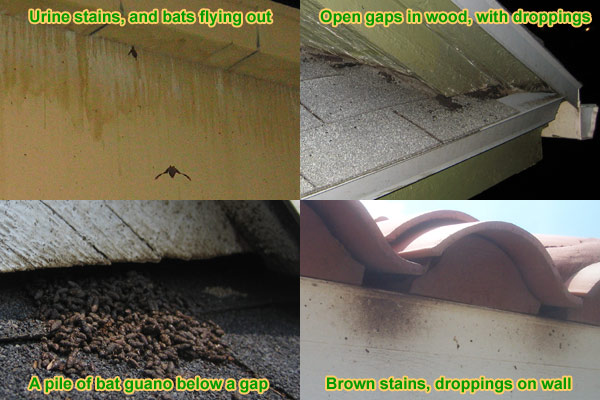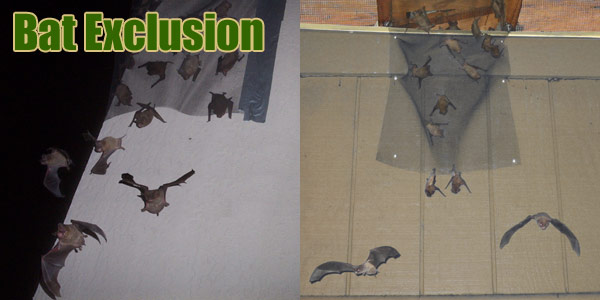Bats are some of the most remarkable creatures that are to be found in North America, and when they live in their natural habitats like caves and hollow trees, they can be worth studying. However, bats are liable to colonize anywhere there is a dark and warm space, and one of their favorite spots will be in the roof cavity or attic space of a home. Once they have moved into the area they will often be unnoticed for some time, but as the colony grows then their activity will become more noticeable.
Removing Bats From Your Home
Because the majority of home infestations of bats will usually have quite a large number of animals, it can often be quite difficult to remove them. There are laws protecting bats because there are so many species that are close to extinction, so the best option is to make the property less attractive to them and to encourage them to leave. If the mothers have young when you discover the infestation it may be wise to let them become old enough to leave of their own volition, as without the mother they will die, and dead bats cause as much problems as the droppings they leave behind.
If there are only a small number of bats, then live traps can be used, but the normal way for professionals to deal with the issue is to find the entry and exit points, and then to deal with them. Simply sealing up these points isn’t going to work, as this will often leave the bats stuck inside the roof and unable to get out. There are a number of one-way mechanisms that are available that can be attached to their exit points, and once they fly out then they won’t be able to get back in. By sealing the majority of exit points and leaving one or two one-way exits in place, most bats will leave and won’t be able to come back.
 Do You Really Want To Remove The Bats?
Do You Really Want To Remove The Bats?
There are many people who won’t mind if they have bats living in their roof, or especially if they are living in a nearby barn because of the positive impact they can have. They will often prey on the kind of insects that will be breeding in the summer months, and bats actually hibernate through the winter.
Sealing Your Roof Cavity
If you have decided that you do want to get rid of the bats, and have used one way traps to ensure that they have all left, the next thing to do is to seal up the roof cavity and to deal with the aftermath. It is important to remember that bats can slip in under a loose roof tile, through a ventilation duct or any gaps in the wooden boards around the roof, and each one will need to be sealed.
Bats will also leave a lot of fecal matter, or guano in their wake and depending on the size of the colony the floor of the roof cavity will often be covered in the stuff. This should be removed, and if any roofing material is too soiled to clean that should be removed too. The roof cavity should then be fumigated or sprayed with a substance to decontaminate the area.
If you want to try to remove the bats yourself, read my
Do It Yourself guide.
If you want to hire a professional to help you, go to my
Hire a Pro page.
If you do hire a company, you can read my
How Much Does Bat Removal Cost? page.
 How to Get Rid of Bats in Attic
How to Get Rid of Bats in Attic
Bats are shy mammals who do not really like human company. However, they can occupy the attic of your house to meet the basic needs of food and water. This would not only cause starching and screaming sounds that can disturb your peaceful night’s sleep but can also cause bad odor. Here are a few ways that can help you in driving away the bats from attic.
Light up the Area -
It is a known fact that bats cannot stand bright light. This is the same reason why they choose to stay in the dark attics. Install work lights or flood nights in the attic to create an uncomfortable environment which would force them to look for an alternate place to hide.
Fast Moving Air -
Similarly, fast moving air also makes them uncomfortable. You might need to install more than one fan depending upon the area. These can be used with or without the lights and can provide the desired results in a couple of days.
Mothballs -
Mothballs are thought by some to be excellent bat repellents, but the truth is that they do not at all affect bat behavior in any way, and they poison the environment. Placing them on all the entry points does not ensure that they do not enter the place.
Killing them is also a terrible idea. Read more about
killing bats in buildings with poison fumigant.
How to Get Rid of Bats in the Eaves
Bats are known to roost in the eaves of the home. They make unpleasant sounds and their droppings contain bacteria and ticks that are certainly not good for your health.
Identify -
Firstly, you would need to identify the area where the bats are roosting. The best way is to walk around on the outside of the house and look for bat droppings in area next to the walls. They would be residing in the area with concentrated droppings.
Mothballs -
The chemical repellents are known to produce pungent smell, but unfortunately that doesn't drive the bats away. Misinformed homeowners, fill mesh bags with mothballs and hang them at the eaves, to no avail.
Outside Bright Light -
Install a bright light in the area outside to the eaves. This would discourage their entry back into the place when they return in the morning.
Bird Netting -
Bird netting is a one-way exclusion device that is installed at the gap between the wall and edge of the eave. It is stapled from three sides while the bottom is left free. This is used by bats to go out; however, they cannot return using the same.
How to Get Rid of Bats in the Fireplace
Bats prefer to take shelter at places that are dark and can protect them from the predators. Fireplace provides a perfect hide out to them and can be a cause of concern for you. There would also be damage to the place in one way or the other. They are also carriers of rabies and can bite humans.
Analyze -
The first thing that you need to do is have a close eye on the outside of home to find out the cracks and holes from where they enter and leave the house. They usually make a move after 15 minutes of the sunset.
Block -
Take a screen and block the fireplace opening on the roof. You must do this only during the night to ensure that none of them is trapped inside. It is also better to do the same after November as the young ones develop wings and go out at this point of time. If you block the place earlier, chances are that there would be a trapped baby bat in the chimney.
Bat Excluder -
Install bat excluder on the cracks and other opening from where you think bats are entering or leaving the house. This would allow them to leave but would prohibit the entry. Read more about
get bats out of the chimney.
How to Get Rid of Bats in the Trees
Bats roosting on the trees are both helpful and harmful to the humans. They relish eating bugs and thus protect the trees from them. However, they themselves damage the fruits.
Pick Fruits when the Ripe -
Bats consume the ripe fruits and thus taking out the preferred source would force them to look for an alternate one. Care should be taken that the fruits are not picked up before they ripe, as they need sugar and other materials from trees to have the right flavor.
Plastic Bags -
Bats are also attracted by the smell of the fruits. Attaching thin plastic bags around them would prevent the smell of fruits from escaping and attracting bats.
Netting -
Thick netting around the tree would help prevent the bats from making their way through. This would also keep other birds out. Care must be taken to ensure that netting goes until the ground so that bats cannot find a way in. The method is an effective one especially when you have a few trees.
Conclusion
Bats can be of wonderful benefit, as they eat other pests like wasps and mosquitoes, so some people will like to have bats, especially if they have colonized a barn or another outhouse. Bat removal and sealing a roof cavity can be tricky work, so most people will need to hire a professional if they want to ensure that bats won’t be able to get back in the roof area.
Do You Need Help? I wrote this website to provide information on How Do You Get Rid of Bats in Buildings in the case that you have
a bat problem and need to make an informed decision about what to do. If you
have any questions you may email me, but I do know from experience
that bat removal is not simple. If you need professional help solving your
wildlife conflict, I recommend that you talk to a professional bat
control expert in your town by clicking on my
National Wildlife Control
directory, which lists experts who I recommend in every USA city and town who can
help you with your bat issue.
More Bat Information: